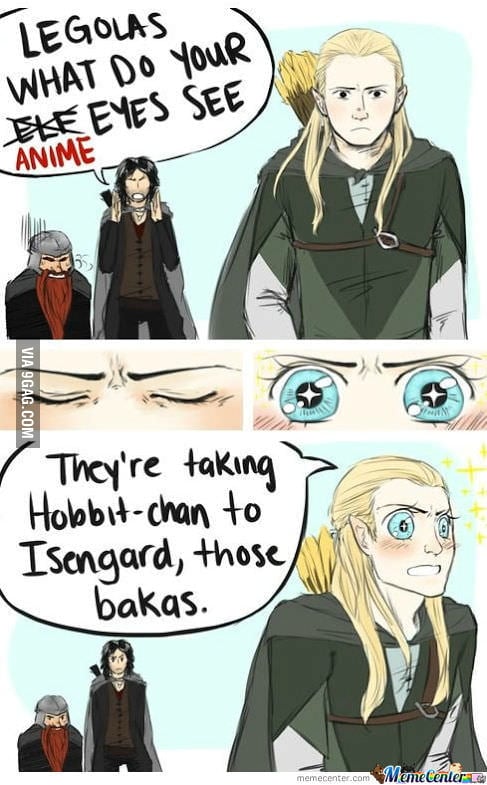
🎵 They’re taking Hobbit-chan to Isengard! 🎵
Biyakugon!
*intense air-slapping ensues*
Elves in LOTR have technically infinite vision because the world used to be flat and illuminated by two glowing trees that resided in Valinor. Because the world was flat, and Elves have essentially perfect vision at any distance, they could actually see things that were on the opposite side of the world.
After Morgoth (aka Melkor, aka the evil god that Sauron worships) and Ungoliant (the mother of Shelob, the spider that nearly kills Frodo) destroyed the trees then the world was made into a globe and Elves infinite vision ability, while still useful, wasn’t quite as powerful as before.
So no they can use sign language to talk to someone on another planet of some other star?
Hmm. That should allow us to estimate the size of that world. The light of the trees must not be so bright as to cook everything in the vicinity; just make it nice and balmy. But, on the opposite side of the world, there must still be enough light to see. Having the occasional photon bounce back would eventually be enough to make out a static scene, but, apparently, it’s possible to see things happening in real time, yes?
Does flat mean that we are talking about something like a simple disc here, or just that a beam of light travels parallel to the ground? The latter would imply a rather strange geometry, which I can’t wrap my mind around. It would make more sense, though, as, obviously, we couldn’t assume that light intensity diminishes with the {ETA:] square of the distance.
It was a disc and the trees were able to be interacted with face to face so I think those are inexplicable except for “they’re magic”.
There’s a wikipedia article with some depictions actually right here: https://en.wikipedia.org/wiki/Two_Trees_of_Valinor#Creation
I have no intuition for how hot or bright these trees would be. They certainly would be very different from the sun. The sun is literally incandescent; white-hot glowing. Trees would presumably use a mechanism comparable to glow-worms to generate radiation only in a very narrow frequency band. The fair skin color of elves suggests that they do not come from a high-UV environment.
Somewhat less than half of the sun’s energy reaches us as visible light (43%). There are a few other factors that might allow the trees to glow brighter than the equatorial sun at noon. Unfortunately, the intensity per area diminishes with the square of the distance, so that doesn’t get us far (no pun intended).
It would be much better if that world was basically rectangular (with reflective sides and top); basically a terrarium. That would also explain why you would place 2 light sources at 1 end. The length of a long rectangular box would only be limited by absorption of the light. The trees should glow brighter at the top. Plants, animals and structures on the surface, near the trees, are hit with only “mild” power, while the high-intensity light near the top of the box is absorbed or scattered by the atmosphere over a long distance. I’m not sure how to work out how long such a box might be. Mainly, I don’t know what assumption to make about that high-intensity light at the top.
Anyway, we should consider that elvish anime eyes originally evolved as an adaption to low-light environments and only later became useful for seeing over long distances, because originally there possibly were no long distances.
they could actually see things that were on the opposite side of the world.
But there’s mountains and slopes and all.
Yeah, you’d have to get up high at least.
I saw a comic about this once (xkcd, probably?) and going by the scene in the movie, where Legolas has human sized eyes, they deduced that Middle Earth must have an exotic atmosphere
It was a Minute Physics video. Only 2 minutes, and a great watch.
Gives any what? Sorry I can’t read that heavily obscured text.
Sounds like you need some anime eyes
From what I’ve heard there’s a serious need to be able to see past tiny censor bars in Japanese media, maybe this explains it
Can he do interferometry and just have a 3rd but normal eye?
I mean, it’s a sunny day FFS!
Legolas actually vibrates very very quickly and is therefore performing synthetic aperture Interferometry, multiplying the size of his effective optical aperture.
Also he’s transmitting and recieving imagery from other elves, using the very long baseline kept in his pants
It depends on the atmosphere. On earth, the average ‘size’ of the atmospheric distortion experienced by a photon over 15 miles would far exceed the angular resolution of any pupil-sized aperture. This is a very simple explanation which groups a number of propagation effects broadly under the term “distortion.” Even without atmospheric distortion, there is a limit to the “information” a given aperture can resolve due to purely thermal noise. In theory, if you have an aperture temperature of absolute zero, the thermal resolution is infinite, but also then there is no process by which information can be generated by an I cident photon.
No, even without an atmosphere you have to contend with the diffraction-limited resolving power through an aperture (pupil), which is related to the diameter of the aperture and the wavelength of light.
A diffraction process is, mathematically, a fourier transform. A fundamental mathematical feature of a fourier transform is what’s known as the uncertainty principle.
Side note: you’ve probably heard of the special case of an uncertainty principle encountered in quantum mechanics frequently misattributed to the head of the Nazi nuclear program (Heisenberg), but this mathematical principle was actually well known for centuries beforehand, and the misattribution is mostly because of Nazi propaganda. We see it anywhere a fourier transform is used, from optics to orbital dynamics to quantum particles. This mathematical phenomenon is frequently miscited as quantum “weirdness” even though there’s nothing quantum (or all that weird) about it.
The pupil restricts the possible positions of incoming photons. A restriction in position increases the variance of momenta (for a photon, speed never changes, but the momentum vector can still change direction). A smaller pupil is more restrictive and causes the image to be blurrier as the incoming photons from each object you are trying to resolve. If you want to be able to resolve smaller angular sizes (small objects at large distances), you need a large aperture that reduces position restrictions on incoming photons and therefore diffraction-induced blurring due to momentum uncertainties.
Look up Airy diffraction for the special case of a circular aperture (e.g. a pupil or telescope).
Orland-Legolas doesn’t need science to look cute.
I forgot that was the actor’s name and for a second thought he’d gotten married.
I don’t think Gimli has a last name. 🤔
Not a scientist nor native English speaker myself, so I’m wondering: shouldn’t that technically say „hypothesis + evidence“ instead of „theory + evidence“? Which is of course nitpicky (if I’m even correct) in the context of a tumblr post, but I’m still curious
A hypothesis is a theory, one that is being tested. It’s got the same root word in both theory and thesis!
I could be entirely wrong about this but isn’t it in-universe lore that Elves don’t see the curvature of the world and that’s how they can see so far?
That would fall under “nonvisual” (meaning not light-based) perception.
✨magic✨
These are the kinds of problems I want our species solving




